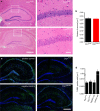Synaptic dysfunction, memory deficits and hippocampal atrophy due to ablation of mitochondrial fission in adult forebrain neurons
- PMID: 25909888
- PMCID: PMC4815974
- DOI: 10.1038/cdd.2015.39
Synaptic dysfunction, memory deficits and hippocampal atrophy due to ablation of mitochondrial fission in adult forebrain neurons
Abstract
Well-balanced mitochondrial fission and fusion processes are essential for nervous system development. Loss of function of the main mitochondrial fission mediator, dynamin-related protein 1 (Drp1), is lethal early during embryonic development or around birth, but the role of mitochondrial fission in adult neurons remains unclear. Here we show that inducible Drp1 ablation in neurons of the adult mouse forebrain results in progressive, neuronal subtype-specific alterations of mitochondrial morphology in the hippocampus that are marginally responsive to antioxidant treatment. Furthermore, DRP1 loss affects synaptic transmission and memory function. Although these changes culminate in hippocampal atrophy, they are not sufficient to cause neuronal cell death within 10 weeks of genetic Drp1 ablation. Collectively, our in vivo observations clarify the role of mitochondrial fission in neurons, demonstrating that Drp1 ablation in adult forebrain neurons compromises critical neuronal functions without causing overt neurodegeneration.
Figures








Similar articles
-
Dynamin-related protein 1 is required for normal mitochondrial bioenergetic and synaptic function in CA1 hippocampal neurons.Cell Death Dis. 2015 Apr 16;6(4):e1725. doi: 10.1038/cddis.2015.94. Cell Death Dis. 2015. PMID: 25880092 Free PMC article.
-
Inhibition of Drp1 provides neuroprotection in vitro and in vivo.Cell Death Differ. 2012 Sep;19(9):1446-58. doi: 10.1038/cdd.2012.18. Epub 2012 Mar 2. Cell Death Differ. 2012. PMID: 22388349 Free PMC article.
-
Mitochondrial fission is a critical modulator of mutant APP-induced neural toxicity.J Biol Chem. 2021 Jan-Jun;296:100469. doi: 10.1016/j.jbc.2021.100469. Epub 2021 Feb 25. J Biol Chem. 2021. PMID: 33639169 Free PMC article.
-
Dynamin-related protein 1: A critical protein in the pathogenesis of neural system dysfunctions and neurodegenerative diseases.J Cell Physiol. 2019 Jul;234(7):10032-10046. doi: 10.1002/jcp.27866. Epub 2018 Dec 4. J Cell Physiol. 2019. PMID: 30515821 Review.
-
Dynamin-related protein 1: A protein critical for mitochondrial fission, mitophagy, and neuronal death in Parkinson's disease.Pharmacol Res. 2020 Jan;151:104553. doi: 10.1016/j.phrs.2019.104553. Epub 2019 Nov 21. Pharmacol Res. 2020. PMID: 31760107 Review.
Cited by
-
Random errors in protein synthesis activate an age-dependent program of muscle atrophy in mice.Commun Biol. 2021 Jun 8;4(1):703. doi: 10.1038/s42003-021-02204-z. Commun Biol. 2021. PMID: 34103648 Free PMC article.
-
Clock-Controlled Mitochondrial Dynamics Correlates with Cyclic Pregnenolone Synthesis.Cells. 2020 Oct 19;9(10):2323. doi: 10.3390/cells9102323. Cells. 2020. PMID: 33086741 Free PMC article.
-
Alterations in hippocampal mitochondrial dynamics are associated with neurodegeneration and recognition memory decline in old male mice.Biogerontology. 2022 Apr;23(2):251-271. doi: 10.1007/s10522-022-09960-3. Epub 2022 Mar 9. Biogerontology. 2022. PMID: 35266060
-
Pyk2 Regulates MAMs and Mitochondrial Dynamics in Hippocampal Neurons.Cells. 2022 Mar 1;11(5):842. doi: 10.3390/cells11050842. Cells. 2022. PMID: 35269464 Free PMC article.
-
Loss of OMA1 delays neurodegeneration by preventing stress-induced OPA1 processing in mitochondria.J Cell Biol. 2016 Jan 18;212(2):157-66. doi: 10.1083/jcb.201507022. J Cell Biol. 2016. PMID: 26783299 Free PMC article.
References
-
- Chen H, Chomyn A, Chan DC. Disruption of fusion results in mitochondrial heterogeneity and dysfunction. J Biol Chem 2005; 280: 26185–26192. - PubMed
Publication types
MeSH terms
Substances
Grants and funding
LinkOut - more resources
Full Text Sources
Other Literature Sources
Molecular Biology Databases
Research Materials
Miscellaneous

